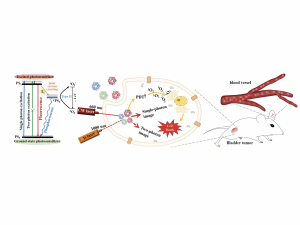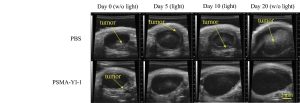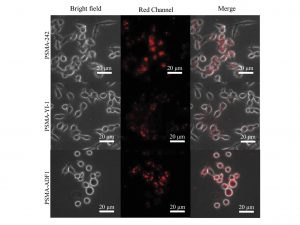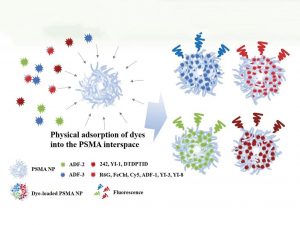Organic near-infrared (NIR) molecules are used in many technologies. In recent years, my research team and I have worked with researchers from various institutions to develop an NIR organic nanosponge and a method for loading NIR organic dyes that promise to improve photodynamic cancer therapy and medical imaging.
Wide Applications of Organic NIR Molecules
NIR light is electromagnetic radiation that has longer wavelengths than visible light and shorter wavelengths than mid-infrared light. When organic NIR molecules are activated, they can absorb, reflect, or emit NIR light. Such materials are widely used in short-range wireless communications, remote temperature sensing, and solar power generation. Moreover, because organic NIR molecules are so tiny, they can easily penetrate our bodies and cells. This makes them useful for cancer diagnosis and medical imaging.
One type of NIR organic molecules, known as ‘dyes’, can be used as photosensitisers in photodynamic therapy (PDT) for cancer. In PDT, doctors inject photosensitisers into the patient’s body, wait for them to accumulate in tumour tissue, and then shine a light of a specific wavelength on the areas to be treated to activate the photosensitisers and generate an active form of oxygen that can destroy the cancer cells nearby.
In addition, organic NIR dyes are often used as fluorescent markers in the canning of medical images. In the patient’s body, the fluorescent marker accumulates in the target molecules and emits fluorescent light. Some dyes are also used as contrast agents in computed tomography to increase the contrast of the image, giving a clearer picture of the patient’s blood vessels and organ structures.
Loading Nanoparticles with NIR Dyes
The use of organic NIR dyes in the field of medicine still faces some limitations. First, many dyes are toxic in living organisms or can cause immune reactions, a property known as low biocompatibility. Secondly, most dyes are poorly soluble in water, which means they are hydrophobic and not hydrophilic. One solution is to create organic NIR nanoparticles that are more biocompatible and less hydrophobic and that can carry organic NIR dyes to their targets.
However, because the molecular structure of every dye is different, the nanoparticles that carry the dye, known as carriers, often have to be tailor-made and they are time-consuming to produce. In addition, the process of synthesising the nanoparticles and loading them with dyes is complex and demands stringent conditions. Therefore, it is difficult to ensure that different batches of carriers have the same properties in large-scale production with conventional techniques. Our team, therefore, aims to develop a simple method to load multiple types of dyes onto the same nanoparticle.
Creating a New Nanosponge
Our team has used poly (styrene-alt-maleic acid), or PSMA, to synthesise a NIR organic nanoparticle, which is a nanopolymer that can carry a wide range of organic NIR dyes. We loaded onto the new PSMA nanoparticles ten dyes, some of which are commercially available and were newly synthesised by us. The new dyes include 424 for the production of organic light-emitting diodes, YI-1, YI-3 and YI-8 for the production of organic solar cells, and ADF-1-3 and DTDPTID for the production of dye-sensitised solar cells. The results show that the PSMA nanoparticles can carry more dyes and are less toxic to the cells than conventional carriers.
Photodynamic Therapy for Cancer
Furthermore, PSMA nanoparticles can be used to destroy solid tumours in PDT. Our team injected PSMA nanoparticles loaded with the YI-1 dye into a group of laboratory mice with bladder cancer. After that, we treated them through PDT with an 808 nm laser or a 660 nm laser for 30 minutes every five days. After two rounds of treatment, the tumours in the mice were significantly reduced in size, especially in those treated with the 808 nm laser, with their cancer cell activities decreasing by more than 50 per cent. At the same time, the tumours in the control group, which were not treated with PSMA nanoparticles, continued to grow and occupied almost the entire bladder by Day 20. Autopsy of the mice revealed that no significant damage or inflammation was found in their hearts, livers, spleens, lungs, or kidneys. This indicates that the PSMA nanoparticles loaded with the dye YI-1 do not produce systemic toxicity, and thus can be an effective and reliable photosensitiser.
To test the effectiveness of the PSMA particles for medical imaging, our team loaded each of three dyes onto PSMA particles and injected them into mice with MB49 bladder cancer cells. Using single photon emission tomography, we found that after 24 hours, all three dyes emitted a fluorescent signal indicating the locations of the tumours. Therefore, we believe that organic NIR dyes with different intensity properties could replace some of the currently used low molecular weight dyes, which will lead to new immunofluorescent staining techniques.
Our team also performed in vitro and in vivo multiphoton laser scans on mice using PSMA nanoparticles with the dye as a contrast agent. The results showed that PSMA nanoparticles are highly biocompatible, have low hydrophobicity, and do not need to cross the cell membrane (called cytokinesis) to enter mouse cells and emit fluorescent signals. We also injected PSMA nanoparticles into the tail vein of mice and found that the particles could flow through the bloodstream to the blood vessels in the ears of the mice. This shows that PSMA nanoparticles can be used as multiphoton contrast agents for medical imaging of deep tissue.
Towards Better Chemotherapy
Through these studies, our team has shown that PSMA nanoparticles can be loaded with a variety of organic NIR dyes for PDT and medical imaging. This discovery offers a new perspective on the use of organic optoelectronic materials for biomedical therapeutic applications and has been published in the Journal of Nanobiotechnology. We believe that such nanoparticles could also be loaded with additional drugs for cancer chemotherapy to reduce the required dose of chemotherapy. Our research team will continue to work in this direction to further identify the huge potential of NIR organic molecules.
Liu Tzu-Ming is an associate professor in the Faculty of Health Sciences at UM. He holds a PhD in optoelectronic engineering from the University of Taiwan. His studies focus on life sciences, the use of ultrafast laser technology to explore of nanophotonics to study cancer biology, and the development of new diagnostic and therapeutic applications of light.
Source: UMagazine ISSUE 26




